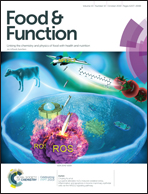Phosphorylation modification of myofibrillar proteins by sodium pyrophosphate affects emulsion gel formation and oxidative stability under different pH conditions†
Abstract
Formation of a gel matrix, involving interactions between proteins, lipids, and water, plays an essential role in the textural properties of processed meats. This study investigated the effects of sodium pyrophosphate (SPP) on the textural properties and oxidative stability of myofibrillar protein (MP)-stabilized emulsion gels under different pH conditions (5.0–9.0). The SPP-modified MP emulsion gels showed an improved elasticity, strength, water-holding capacity, and oxidative stability at pH 6.0 and 7.0. This improvement should be mainly attributed to the enhanced protein–protein crosslinks via ionic interaction between phosphate groups and –NH3+ of amino acids, which were homogeneously formed among adsorbed and/or unadsorbed proteins, entrapping fractions of MPs (myosin heavy chain, actin, and troponin T) within the network. Therefore, the oil droplets were better adherent to the gel matrix. Nevertheless, increased electrostatic repulsion between protein molecules due to excessive phosphates attached to MPs at pH 8.0 and 9.0, as well as protein precipitation at pH 5.0, caused the collapse of the MP-stabilized emulsion gel structure, and thus, overall decreased the gel properties and oxidative stability. LC-MS/MS results confirmed that phosphate groups were successfully introduced to MPs through C–O–P bonds at pH 6.0, and the phosphorylation sites were found to be on serine residues (Ser14, Ser79, Ser96, Ser148, Ser2427, and Ser5272), threonine residues (Thr118 and Thr926), and tyrosine residues (Tyr215 and Tyr425). The results provided a new aspect for better understanding the effect of polyphosphates in meat protein/oil composite systems.



 Please wait while we load your content...
Please wait while we load your content...